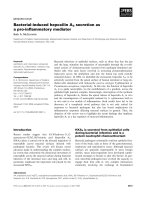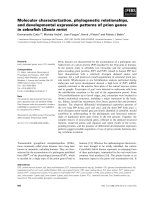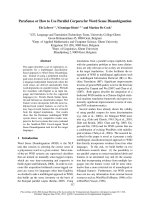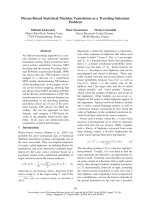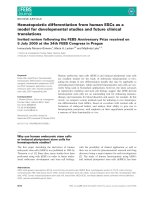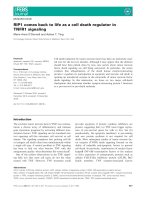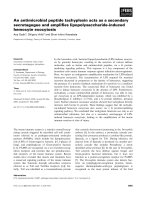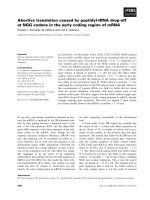Báo cáo khoa học: "Cystatin C: unsuited to use as a marker of kidney function in the intensive care unit" pot
Bạn đang xem bản rút gọn của tài liệu. Xem và tải ngay bản đầy đủ của tài liệu tại đây (28.23 KB, 2 trang )
531
GFR = glomerular filtration rate.
Available online />We read with interest the article by Villa and coworkers [1]
advocating the use of cystatin C as a measure of glomerular
filtration rate (GFR) in critically ill patients. However, we should
like to draw attention to several flaws in this study. First, Villa
and coworkers compared cystatin C with creatinine as a
measure of GFR, using body surface corrected creatinine
clearance as, what they call, a ‘gold standard’. However, in the
Discussion section of that report inulin and iothalamate
clearances are mentioned as gold standards, but they were
not used by these investigators. The use of body surface area
corrected creatinine clearance is questionable in both obese
and excessively lean individuals because the correlation
between surface area and lean body mass may be lost. Both
types of patients are frequently encountered in intensive care.
Second, Villa and coworkers employ a cutoff of 80 ml/min to
identify renal dysfunction, whereas a value of 50 ml/min is
generally accepted [2]. This could have a major influence on
the presented results. Third, patients with thyroid disorders or
on corticosteroid therapy were excluded. Almost all patients
with critical illness have low tri-iodothyronine values because
of changes in thyroid hormone metabolism (‘nonthyroidal
illness’), thus making recognition of thyroid disorders
problematic. Finally, we showed [3] that, in patients with
thyroid dysfunction, cystatin C is not a suitable measure of
GFR. In hypothyroidism creatinine levels are elevated but
cystatin C levels are low, whereas in hyperthyroidism
creatinine levels are low and cystatin C levels elevated.
Taken together, we disagree with the authors that cystatin C
could be used as a marker of GFR in intensive care patients.
Letter
Cystatin C: unsuited to use as a marker of kidney function in the
intensive care unit
Raymond Wulkan
1
, Jan den Hollander
2
and Arie Berghout
2
1
Clinical Biochemist, Department of Clinical Chemistry, Hospital MCRZ, Rotterdam, The Netherlands
2
Consultant Physician, Department of Internal Medicine, Hospital MCRZ, Rotterdam, The Netherlands
Corresponding author: Raymond Wulkan,
Published online: 10 May 2005 Critical Care 2005, 9:531-532 (DOI 10.1186/cc3541)
This article is online at />© 2005 BioMed Central Ltd
See related research by Villa et al., issue 9.2 [ />Authors’ response
P Villa, M Jiménez, M-C Soriano, J Manzanares and P Casasnovas
We read with interest the letter from Wulkan and coworkers
about the use of cystatine C as a marker of glomerular
filtration. The gold standard parameters for monitoring renal
function are clearances of exogenous substances (inulin,
[125]iothalamate, etc.), and in clinical practice the more
extensively used markers of glomerular function, despite their
limitations, are serum creatinine and creatinine clearance. In
our opinion creatinine clearance represents a reasonably
accurate and reliable estimate of GFR and is better than
serum creatinine, at least in critically ill patients. Therefore, we
compared serum cystatin C and serum creatinine with body
surface corrected creatinine clearance. Morbidly obese
patients were excluded from the study because of the
possible perturbation in the calculation of body surface
corrected creatinine clearance.
In their letter, Wulkan and coworkers comment on the fact
that we employed 80 ml/min per m
2
creatinine clearance as
the cutoff point to identify renal dysfunction instead of the
more generally accepted 50 ml/min per m
2
. Although
50 ml/min per m
2
is the more commonly used cutoff point,
other studies [4,5] used a cutoff point of 84 ml/min per m
2
.
We felt that it would be interesting to evaluate a more
sensitive marker of early renal dysfunction in critically ill
patients, and therefore we employed a cutoff point of
80 ml/min per m
2
in our study.
In relation to the impact thyroid dysfunction has on serum
cystatin C, the study reported by Wulkan and coworkers [3]
was conducted in a hyperthyroid or hypothyroid population,
and so patients with known thyroid disease were excluded
532
Critical Care October 2005 Vol 9 No 5 Wulkan et al.
from the study. ‘Nonthyroidal illness’ is common in critically ill
patients. This disorder typically presents with low free tri-
iodothyronine values, generally normal free tetra-
iodothyronine and normal thyroid-stimulating hormone, which
confounds extrapolation of published data in this population.
We feel that future studies to evaluate this issue are
warranted.
Competing interests
The author(s) declare that they have no competing interests.
References
1. Villa P, Jiménez M, Soriano MC, Manzanares J, Casasnovas P:
Serum cystatin C as a marker of acute renal dysfunction in
critically ill patients. Crit Care 2005, 9:R139-R143.
2. O’Riordan SE, Webb MC, Stowe HJ, Simpson DE, Kandarpa M,
Coakly AJ, Newman DJ, Saunders JA, Lamb EJ: Cystatin C
improves the detection of mild renal function in older patients.
Ann Clin Biochem 2003, 40:648-655.
3. Den Hollander JG, Wulkan RW, Mantel MJ, Berghout A. Is cys-
tatin C a marker of glomerular filtration rate in thyroid dys-
function? Clin Chem 2003, 49:1558-1559.
4. Bökenkamp A, Domanetzki M, Zinck R, Schumann G, Byrd D,
Brodehl J: Cystatin C serum concentrations underestimate
glomerular filtration rate in renal transplant recipients. Clin
Chem 1999, 49:1866-1868.
5. Coll E, Botey A, Alvarez L, Poch E, Quintó LI, Taurina A, Vera M,
Piera C, Darnell A: Serum cystatin C as a new marker for non-
invasive estimation of glomerular filtartion rate and as a
marker for early renal impairment. Am J Kidney Dis 2000, 36:
29-34.
